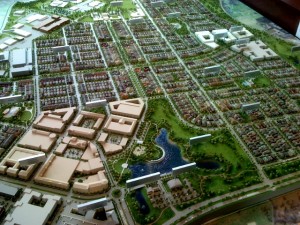What if we designed our communities in a way that fostered more social interaction? This could be done with design plans that include front porches rather than back decks, and neighborhoods with shared green space rather than large individual yards. It might help to create a sense of greater social connection within that community. This was one of the 7 policy ideas developed in the Interactivity Foundation (IF) project on Shaping our Towns and Cities, the policy of “Designing Communities for Social Interaction.” The reality of this policy idea is the subject of a recent NPR story on the Mueller new urbanist development in Austin, TX.
In our IF discussions the participants imagined that another effect of designing a community for social interaction could be an improvement in health. With sidewalks, paths, and shared green space (rather than large single family yards) people might be out an about more, walking through their neighborhood. That’s one of the results NPR highlighted in their story:
A research team from Texas A&M University polled Mueller residents and what they found was striking. After moving here, respondents said, they spend an average of 90 fewer minutes a week in the car, and most reported higher levels of physical activity.
The poll results seem to validate new-urbanist gospel: good design, like sidewalks, street lighting, extensive trails and parkland, can improve social and physical health. Several mornings a week, a group of retired guys power walk through Mueller.
“We’ve lost weight. We’re certainly more fit than we used to be,” says Don Dozier, a retired accounting professor. He and his wife, Janelle, moved here in 2008 from a conventional subdivision south of Austin that had no sidewalks. “I think probably the main thing is that we have made an incredible number of friends,” he adds.
You can explore the rest of the policy possibilities for Shaping our Towns and Cities here–including a related policy focused on Maximizing Access and Mobility Freedom. It turns out a more pedestrian and transit-friendly community is also one that might encourage more social interaction and foster more social connectedness.


